Improving bioavailability of lignocellulosic biomass by pretreatment with the marine fungus Chaetomium sp. CS1
IF 4.1
2区 环境科学与生态学
Q2 BIOTECHNOLOGY & APPLIED MICROBIOLOGY
International Biodeterioration & Biodegradation
Pub Date : 2025-02-22
DOI:10.1016/j.ibiod.2025.106031
引用次数: 0
Abstract
Crop straw and waste wood are abundant renewable biomass resources, but their complex lignocellulose composition limits industrial use. This study introduces an eco-friendly solution by bio-converting lignocellulosic biomass into biofuels and biochemicals using Chaetomium sp. CS1, a deep-sea fungus that degrades 55% of alkali lignin in 10 days. Gas chromatography-mass spectrometry (GC-MS) analysis indicated guaiacol as the primary pyrolysis product from G-type lignin, which could be further converted into alkanes and other intermediates. Transcriptomic analysis identified numerous genes encoding ligninolytic enzymes, including highly induced AA3 family enzymes with oxidoreductase and monooxygenase activities, during lignin degradation. A copper-containing nitrite reductase gene was significantly induced, enhancing denitrification and reducing nitrite to aid detoxification. Fungal pretreatment significantly improved the digestibility of sawdust by black soldier fly larvae, enhancing the bioavailability of lignocellulosic materials. These knowledge into fungal lignin degradation provide a basis for efficient lignocellulose pretreatment, enabling high-value biofuel and bioproduct production.
用海洋真菌 Chaetomium sp. CS1 进行预处理,提高木质纤维素生物质的生物利用率
农作物秸秆和废木材是丰富的可再生生物质资源,但其复杂的木质纤维素组成限制了工业利用。这项研究介绍了一种生态友好的解决方案,利用毛藻CS1将木质纤维素生物质转化为生物燃料和生化物质,毛藻CS1是一种深海真菌,在10天内降解55%的碱木质素。气相色谱-质谱(GC-MS)分析表明,愈创木酚是g型木质素的主要热解产物,可进一步转化为烷烃和其他中间体。转录组学分析发现了许多编码木质素降解酶的基因,包括在木质素降解过程中高度诱导的具有氧化还原酶和单氧化酶活性的AA3家族酶。一个含铜的亚硝酸盐还原酶基因被显著诱导,增强了反硝化作用,减少了亚硝酸盐,帮助解毒。真菌预处理显著提高了黑虻幼虫对木屑的消化率,提高了木质纤维素材料的生物利用度。这些关于真菌木质素降解的知识为有效的木质纤维素预处理提供了基础,从而实现高价值生物燃料和生物产品的生产。
本文章由计算机程序翻译,如有差异,请以英文原文为准。
求助全文
约1分钟内获得全文
求助全文
来源期刊
CiteScore
9.60
自引率
10.40%
发文量
107
审稿时长
21 days
期刊介绍:
International Biodeterioration and Biodegradation publishes original research papers and reviews on the biological causes of deterioration or degradation.

 求助内容:
求助内容: 应助结果提醒方式:
应助结果提醒方式:


